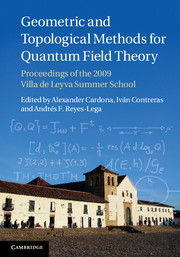 Geometric and Topological Methods for Quantum Field Theory
Geometric and Topological Methods for Quantum Field Theory Book contents
- Frontmatter
- Contents
- List of contributors
- Introduction
- 1 A brief introduction to Dirac manifolds
- 2 Differential geometry of holomorphic vector bundles on a curve
- 3 Paths towards an extension of Chern–Weil calculus to a class of infinite dimensional vector bundles
- 4 Introduction to Feynman integrals
- 5 Iterated integrals in quantum field theory
- 6 Geometric issues in quantum field theory and string theory
- 7 Geometric aspects of the Standard Model and the mysteries of matter
- 8 Absence of singular continuous spectrum for some geometric Laplacians
- 9 Models for formal groupoids
- 10 Elliptic PDEs and smoothness of weakly Einstein metrics of Hölder regularity
- 11 Regularized traces and the index formula for manifolds with boundary
- Index
- References
7 - Geometric aspects of the Standard Model and the mysteries of matter
Published online by Cambridge University Press: 05 May 2013
- Frontmatter
- Contents
- List of contributors
- Introduction
- 1 A brief introduction to Dirac manifolds
- 2 Differential geometry of holomorphic vector bundles on a curve
- 3 Paths towards an extension of Chern–Weil calculus to a class of infinite dimensional vector bundles
- 4 Introduction to Feynman integrals
- 5 Iterated integrals in quantum field theory
- 6 Geometric issues in quantum field theory and string theory
- 7 Geometric aspects of the Standard Model and the mysteries of matter
- 8 Absence of singular continuous spectrum for some geometric Laplacians
- 9 Models for formal groupoids
- 10 Elliptic PDEs and smoothness of weakly Einstein metrics of Hölder regularity
- 11 Regularized traces and the index formula for manifolds with boundary
- Index
- References
Summary
Abstract
The basic structure of gauge theories of fundamental interactions distinguishes radiation from matter. Radiation is described by Yang–Mills theories, matter particles (i.e. quarks and leptons) are described by a Dirac operator which contains the full complexity of their classification and state mixing. In quantum field theory the two categories intermingle. While the construction of Yang–Mills theories, in essence, is a classical one, the phenomenon of spontaneous symmetry breaking exhibits facets which are linked to the quantum symmetries of gauge theories. Furthermore, noncommutative geometry offers new routes to the standard model of electroweak interactions and reveals some of its otherwise mysterious structure.
We review these matters with regard to both their phenomenology and their theoretical and geometric background. Many examples are given and exercises are provided which illustrate some of the main results.
Radiation and matter in gauge theories and General Relativity
The basic structure of gauge theories seems to distinguish radiation from matter as two categories of different origin. The massive and massless vector or tensor bosons, the photon, the W±- and Z0-bosons, the gluons, and the graviton, respectively, which are the carriers of the fundamental forces, belong to what may be termed radiation. Here we allude to the analogy to (quantum) electrodynamics described by Maxwell's equations and to Einstein's equations for General Relativity (GR). They are described by geometric theories, i.e. Yang–Mills (YM) theories or, in the case of GR, by semi-Riemannian geometry in dimension 4. To a large extent, they are classical theories.
- Type
- Chapter
- Information
- Geometric and Topological Methods for Quantum Field TheoryProceedings of the 2009 Villa de Leyva Summer School, pp. 274 - 306Publisher: Cambridge University PressPrint publication year: 2013
